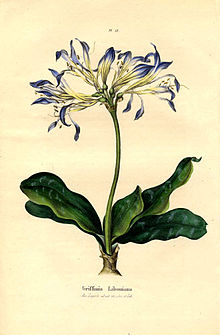Griffinia: Difference between revisions
ShortDescBot (talk | contribs) ShortDescBot adding short description "Genus of flowering plants" |
Conan Wolff (talk | contribs) new section conservation |
||
| Line 42: | Line 42: | ||
**''[[Griffinia nocturna]]'' |
**''[[Griffinia nocturna]]'' |
||
**''[[Griffinia gardneriana]]'' |
**''[[Griffinia gardneriana]]'' |
||
==Conservation== |
|||
''Griffinia intermedia'' is categorized as endangered (EN) by the IUCN Red List of Threatened Species. It is only known from two locations, in which the species, as well as its habitat is continually declining.<ref name = "Moraes, 2016">Moraes, L. 2016. ''Griffinia intermedia''. The IUCN Red List of Threatened Species 2016: e.T107250175A107302180. https://dx.doi.org/10.2305/IUCN.UK.2016-3.RLTS.T107250175A107302180.pt. Accessed on 15 May 2023.</ref> |
|||
==References== |
==References== |
||
Revision as of 18:00, 15 May 2023
| Griffinia | |
|---|---|

| |
| Griffinia liboniana[2] | |
| Scientific classification | |
| Kingdom: | Plantae |
| Clade: | Tracheophytes |
| Clade: | Angiosperms |
| Clade: | Monocots |
| Order: | Asparagales |
| Family: | Amaryllidaceae |
| Subfamily: | Amaryllidoideae |
| Tribe: | Griffineae |
| Genus: | Griffinia Ker-Gawl.[1] |
| Synonyms[3] | |
| |
Griffinia is a genus of Brazilian plants in the Amaryllis family, subfamily Amaryllidoideae.[5] It includes 21 known species which are endemic to Brazil in South America. The most closely related genus to it is the monotypic Worsleya.
The members of the genus Griffinia are tropical, bulbous plants which grow in high levels of humidity. The leaves are green, petiolate, elliptical, sometimes with white speckles on them. The flowers are typical for the tribe - lilac or blue colored (although there are also white - colored species) and collected into an umbel. Many of the members in this genus are endangered because of the deforestation of their habitat.[6]
Taxonomy
The genus Griffinia includes 2 subgenera and 21 known species.[3]
- Subgenus Griffinia - includes the typical blue-flowering members of the genus.
- Griffinia alba
- Griffinia aracensis
- Griffinia arifolia
- Griffinia colatinensis
- Griffinia concinna
- Griffinia cordata
- Griffinia espiritensis
- Griffinia hyacinthina
- Griffinia ilheusiana
- Griffinia intermedia
- Griffinia itambensis
- Griffinia leucantha
- Griffinia liboniana
- Griffinia mucurina
- Griffinia ornata
- Griffinia parviflora
- Griffinia paubrasilica
- Griffinia rochae
- Griffinia rostrata
Conservation
Griffinia intermedia is categorized as endangered (EN) by the IUCN Red List of Threatened Species. It is only known from two locations, in which the species, as well as its habitat is continually declining.[7]
References
- ^ Ker Gawler, John Bellenden 1820. Botanical Register 6, plate 444 + 2 subsequent text pages full-page color illustrion, description in Latin, commentary in English
- ^ illustration from Annales de la Société royale d’Agriculture et de Botanique de Gand, Journal d’horticulture by Charles Morren (editor). Gand [Gent], Local de la Société (Casino), etc., 1845, volume 1, plate 13. Hand-coloured lithograph by Alex. Lagarde
- ^ a b Kew World Checklist of Selected Plant Families
- ^ The International Plant Names Index, search for Libonia
- ^ Stevens, P.F., Angiosperm Phylogeny Website: Asparagales: Amaryllidoideae
- ^ Preuss, Kevin D. 2000. The Genus Griffinia Ker Gawler (Amaryllidaceae), Revisited. Herbertia 54(1999): 51-66.
- ^ Moraes, L. 2016. Griffinia intermedia. The IUCN Red List of Threatened Species 2016: e.T107250175A107302180. https://dx.doi.org/10.2305/IUCN.UK.2016-3.RLTS.T107250175A107302180.pt. Accessed on 15 May 2023.
